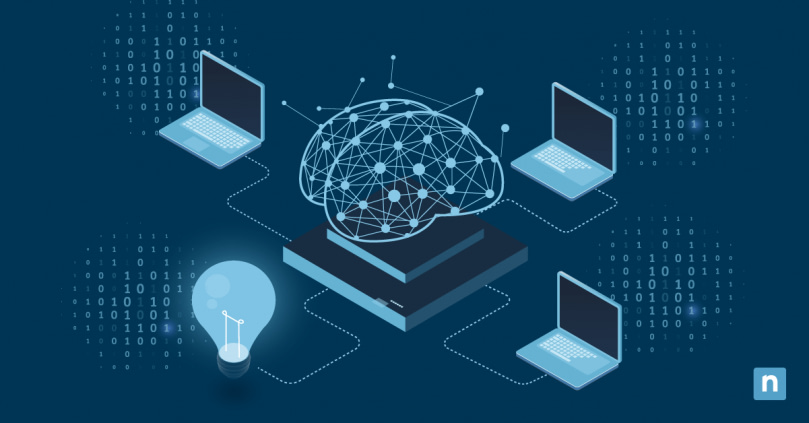Staying ahead in the world of modern IT requires more than just keeping systems running — it demands continuous learning and growth. With that in mind, learning how to create a culture of IT learning within your organization isn’t just a perk; it’s a necessity to stay competitive and ensure your team remains adaptable. Let’s explore how to create an environment that encourages ongoing education, fosters innovation, and helps your IT staff thrive in an ever-evolving industry.
Understanding continuous IT learning
Continuous IT learning refers to the ongoing process of developing and enhancing skills and expertise in the field of information technology. This learning model goes beyond formal education and certifications, emphasizing real-time learning through hands-on experience, peer collaboration, and self-driven exploration of emerging technologies.
For IT professionals, continuous learning is crucial. It sharpens technical skills, improves problem-solving abilities, and ensures they can implement the latest best practices. For organizations, fostering a culture of continuous learning directly translates into higher productivity, improved service delivery, and a competitive edge in innovation. As the landscape shifts, teams that commit to learning are more agile and better positioned to respond to new challenges and opportunities.
Several companies have experienced the benefits of continuous IT learning. For instance, Adobe encourages its IT teams to pursue certifications and training programs on the latest technologies, resulting in a faster adoption of cloud-based services. Similarly, Amazon’s culture of learning allows its employees to stay at the forefront of AI and machine learning innovations, driving its success as a tech giant.
Key components of a continuous learning culture
Building a lifelong learning culture among IT professionals is a thoughtful approach that fosters growth and development at every level. Here are the key components that contribute to a thriving learning environment:
Encouraging a growth mindset
Promote the belief that skills and abilities can be developed through dedication and hard work. A growth mindset helps employees embrace challenges, learn from mistakes, and continuously improve their technical capabilities.
Providing access to learning resources
Ensure that team members have the tools they need to expand their knowledge. This includes offering online courses, certifications, webinars, and in-person workshops to help them stay up to date with the latest trends and technologies.
Setting clear learning and development goals
Establish specific, measurable goals for each team member’s learning journey. Align these goals with both individual career aspirations and organizational needs to ensure progress and relevance.
Creating a supportive environment for knowledge sharing and collaboration
Encourage open communication and collaboration among team members. A culture where people freely share insights, best practices, and lessons learned fosters faster learning and creates a more cohesive, innovative team.
Strategies for fostering continuous IT learning
Implementing strategies to encourage continuous learning requires commitment from both leadership and the team. Here are proven strategies to create and sustain a culture of IT learning:
Leadership’s role
Leadership sets the tone for an IT learning culture. When managers and executives actively pursue learning and demonstrate its value, it inspires the rest of the team to follow suit. Leaders should regularly participate in training, discuss what they’re learning, and encourage others to do the same.
Structured training programs and learning paths
Offering structured learning paths tailored to different roles within your IT team ensures employees have a clear roadmap for developing their skills. These programs can include a mix of technical training, soft skills development, and certifications relevant to their positions.
Incentivizing learning
Recognize and reward employees who invest time in learning. Whether through bonuses, certifications, or public acknowledgment, creating incentives motivates team members to engage in ongoing education. This can also help align learning goals with career advancement opportunities.
E-Learning platforms and internal knowledge bases
Utilize e-learning platforms and internal knowledge bases to make learning accessible to all team members. These tools provide flexibility, allowing employees to learn at their own pace while having a repository of valuable resources available whenever needed.
Peer-to-peer learning and mentoring programs
Peer-to-peer learning and mentoring programs facilitate knowledge transfer and collaboration. Experienced team members can mentor newer employees, helping them navigate complex systems or develop specific skills. This not only strengthens relationships but also accelerates the learning process within the team.
Overcoming challenges in building a continuous learning culture
Building a culture of continuous IT training and education isn’t without its challenges. Time constraints, budget limitations, and resistance to change are common hurdles. Here are some of the obstacles you may face and strategies to overcome them:
- Time constraints: IT teams often struggle to find time for learning due to the demands of their daily tasks. To overcome this, organizations can allocate dedicated time for learning, such as offering “learning hours” during the workweek or scheduling training sessions during low-demand periods. Encouraging micro-learning — short, focused learning sessions — can also help employees fit education into their busy schedules.
- Budget limitations: Providing access to high-quality training resources can be costly. One way to address this challenge is by taking advantage of free or low-cost learning platforms, such as open-source courses or community-driven resources. Additionally, offering group-based training or internal workshops can reduce costs while still providing valuable learning opportunities.
- Resistance to change: Some team members may resist adopting a learning culture, especially if they’re comfortable with their current skill set. To overcome this, leadership can demonstrate the long-term benefits of continuous learning, showing how it leads to personal growth and opportunities for career advancement. Engaging these employees with practical, hands-on training sessions may also make learning more approachable.
- Balancing immediate needs with long-term learning: IT teams are often focused on solving immediate problems, which can make long-term learning feel like a low priority. Encourage a mindset that emphasizes both immediate problem-solving and long-term growth by integrating learning into the workflow. For example, after resolving issues, teams can discuss lessons learned and explore ways to improve in the future, blending real-time work with education.
Benefits of a continuous IT learning culture
Fostering a culture of continuous IT learning brings tangible benefits to both employees and the organization. Here are some of the key advantages:
Improved employee engagement and job satisfaction
When employees have opportunities to grow and develop, they feel more engaged in their roles. Continuous learning empowers team members, giving them a sense of accomplishment and purpose as they gain new skills. This increased engagement leads to higher job satisfaction and morale.
Enhanced innovation and adaptability
A learning culture encourages employees to stay on top of the latest trends and technologies. This proactive approach fosters innovation, allowing teams to experiment with new tools and techniques. It also ensures the organization can quickly adapt to industry changes, maintaining a competitive edge.
Better team performance
As employees sharpen their skills and gain expertise, they become more efficient and effective in their roles. This directly impacts team performance, leading to faster problem resolution, better decision-making, and increased overall productivity.
Increased employee retention and talent attraction
Offering continuous learning opportunities helps retain top talent by providing clear paths for career growth. Employees are more likely to stay with an organization that invests in their development. Additionally, a strong learning culture can attract new talent, as professionals seek out companies that prioritize skill-building and professional advancement.
Competitive advantage
Organizations with a culture of continuous IT learning are better positioned to innovate, adapt, and meet market demands. This gives them a distinct advantage over competitors who may struggle to keep pace with technological advancements. By investing in learning, companies can set themselves apart as leaders in the industry.
Case studies and examples
Many companies have successfully implemented a continuous IT learning culture, reaping substantial benefits from their efforts. Here are a few examples of organizations that have thrived by fostering an environment of ongoing learning:
- Microsoft’s Learn-It-All Culture
Under the leadership of CEO Satya Nadella, Microsoft transformed its culture from a “know-it-all” to a “learn-it-all” mindset. This shift emphasized continuous learning across all departments, particularly in IT. By encouraging employees to constantly expand their skills, Microsoft has been able to stay at the forefront of innovation in cloud computing, artificial intelligence, and software development. One key takeaway from Microsoft’s approach is the importance of leadership in setting the tone for a learning-first mentality and empowering employees to pursue new knowledge without fear of failure. - Google’s 20% Time Initiative
Google has long been known for fostering a culture of continuous learning, particularly through its 20% time initiative, where employees are encouraged to spend 20% of their work hours exploring personal projects and new technologies. This program has led to innovations like Gmail and Google News. For IT teams, this freedom to explore and experiment has resulted in new problem-solving approaches and technical solutions. Google’s case illustrates how giving employees structured freedom to learn and experiment can drive both individual growth and company-wide innovation. - Accenture’s Technology Quotient (TQ) Program
Accenture implemented the TQ program to ensure its employees remain technologically savvy and adaptable. Through this program, employees complete courses and assessments to increase their proficiency in emerging technologies such as blockchain, AI, and cloud solutions. Accenture also built internal knowledge-sharing platforms to facilitate continuous learning. The lesson here is the value of structured learning paths coupled with technology-driven platforms to provide employees with on-demand access to learning materials.
Lessons learned and best practices
From these case studies, several best practices emerge:
- Leadership involvement is crucial: Successful learning cultures are championed from the top down, with leadership actively promoting and participating in learning initiatives.
- Offer structured yet flexible learning opportunities: Companies benefit from creating structured training programs while also giving employees the freedom to explore their own learning paths.
- Leverage technology for learning: E-learning platforms, internal knowledge bases, and collaborative tools are essential to make learning accessible and scalable within IT teams.
- Encourage experimentation and risk-taking: Allowing employees to experiment and learn from failures can spark innovation and creative problem-solving throughout the organization.
Practical tips for getting started
Building a continuous learning culture within your IT team requires a clear plan and deliberate action. Follow this step-by-step guide to initiate an IT learning culture in your company and measure its success:
Step-by-step guide to fostering a continuous learning culture
- Assess your team’s current skills and needs
Begin by evaluating the skill sets already present in your IT team. Identify gaps in knowledge, areas for improvement, and potential growth opportunities. This will provide a baseline to structure learning paths and ensure that training is relevant. - Set clear goals for learning and development
Align learning goals with both business objectives and individual career paths. Whatever the desired outcome, setting clear and measurable goals ensures that learning initiatives have a defined purpose. - Create a structured learning plan
Develop a learning roadmap that outlines the courses, certifications, or workshops available to your team. Incorporate a mix of formal training, self-paced learning, and hands-on projects. Consider offering tiered programs based on expertise levels to ensure that learning is scalable across different roles. - Provide easy access to learning resources
Make learning materials readily available through e-learning platforms, internal knowledge bases, or external certifications. Giving employees access to learning resources at any time ensures they can engage with training when it fits their schedule. - Encourage peer collaboration and knowledge sharing
Facilitate an environment where team members can share insights with one another. Peer-to-peer learning and mentorship programs are effective ways to speed up knowledge transfer and foster a sense of teamwork. - Reward and recognize progress
Motivate your team by recognizing and rewarding their learning achievements. This could be through public acknowledgment or opportunities for advancement. Positive reinforcement helps maintain momentum and demonstrates the value of continuous learning.
Tips for measuring the success of learning initiatives
- Track learning engagement
Measure how many team members are actively participating in learning activities. - Assess skill improvement and application
After training, evaluate how well employees are applying new skills to their daily tasks. This can be done through performance reviews, project outcomes, and feedback from managers or colleagues. - Collect employee feedback
Regularly survey your team to get their thoughts on the learning resources provided and the overall experience. - Tie learning outcomes to business results
Track whether the adoption of new skills leads to faster problem resolution, fewer errors, or enhanced service delivery. - Monitor retention and job satisfaction rates
Keep an eye on these metrics to understand how continuous learning affects overall employee happiness and commitment to the organization.
In summary
Creating a culture of continuous IT learning is not just a strategy for improving technical skills—it’s an investment in your team’s long-term success. By fostering a growth mindset, providing accessible learning opportunities, and creating a supportive environment for collaboration, you empower your IT professionals to adapt and thrive in an ever-evolving industry.
The benefits extend well beyond IT skill development, leading to enhanced innovation, improved team performance, and a stronger competitive position. With a clear plan and a commitment to lifelong learning, your organization can unlock its full potential and stay ahead of the curve.








